Choosing the right wood flooring for your home is a significant decision that can enhance the aesthetic appeal and value of your property. With numerous options available, it’s crucial to understand the differences between various types of wood flooring and the factors to consider before making a choice. This guide will help you navigate the world of wood flooring and find the best option for your UK home.
Introduction
Wood flooring remains a popular choice in the UK for its timeless beauty, durability, and versatility. Whether you’re renovating an existing space or building a new home, selecting the right wood flooring can transform your interiors. It’s essential to consider the type of wood, room usage, climate, budget, and design preferences to make an informed decision.
Types of Wood Flooring
Solid Wood Flooring
Description and Characteristics: Solid wood flooring is made from a single piece of timber, offering natural beauty and strength. Each plank is milled from a solid piece of wood, typically available in various species like oak, maple, and walnut.
Pros and Cons:
- Pros: Long-lasting, can be sanded and refinished multiple times, adds value to the home.
- Cons: Susceptible to moisture and temperature changes, higher installation cost, requires professional installation.
Engineered Wood Flooring
Description and Characteristics: Engineered wood flooring consists of a top layer of real wood veneer bonded over multiple layers of plywood or high-density fiberboard (HDF). This construction provides enhanced stability.
Pros and Cons:
- Pros: More resistant to moisture and temperature fluctuations, easier to install, can be installed over concrete.
- Cons: Limited refinishing options, may not have the same lifespan as solid wood flooring.
Parquet Wood Flooring
Description and Characteristics: Parquet flooring is made up of small pieces of wood arranged in geometric patterns, such as herringbone or chevron. It offers a distinctive and elegant look.
Pros and Cons:
- Pros: Unique and stylish design, adds character to any room, durable.
- Cons: Higher installation cost, requires professional installation, can be more challenging to maintain.
Factors to Consider When Choosing Wood Flooring
Room Usage and Traffic
Consider the level of foot traffic in the room where the flooring will be installed. High-traffic areas like hallways and living rooms require more durable flooring options, while low-traffic areas can accommodate softer woods.
Climate and Humidity
The UK climate can be humid, which affects wood flooring. Engineered wood is better suited for areas with fluctuating humidity levels due to its stable construction. Solid wood may expand or contract with changes in moisture.
Budget
Your budget plays a significant role in your choice. Solid wood flooring tends to be more expensive due to its material and installation costs, while engineered wood and parquet options can offer more budget-friendly alternatives.
Installation Process
Decide whether you’ll install the flooring yourself or hire a professional. Engineered wood flooring often comes with click-lock installation systems, making it easier for DIY projects, while solid wood and parquet may require professional installation.
Maintenance and Durability
Cleaning and Care Tips
Different types of wood flooring require different maintenance approaches. Regular sweeping and damp mopping with appropriate wood cleaners can keep your floors looking pristine. Avoid excessive water and harsh chemicals that can damage the wood.
Long-term Durability and Potential Issues
Solid wood flooring can last for decades with proper care, while engineered wood offers good durability but may have a shorter lifespan. Consider potential issues like scratches, dents, and moisture damage when making your choice.
Aesthetics and Design
Matching Wood Flooring with Interior Design Styles
Wood flooring should complement your overall interior design. Consider the colour, texture, and plank size to match your style. Light woods can make a room feel more spacious, while dark woods add warmth and elegance.
Colour, Texture, and Plank Size Options
Choose from a variety of finishes, from matte to high gloss, and textures like hand-scraped or smooth. Plank size can also influence the room’s look – wider planks create a modern feel, while narrow planks offer a traditional look.
Sustainability and Environmental Impact
Eco-friendly Wood Flooring Options
Opt for wood flooring that is sourced sustainably. Look for certifications like FSC (Forest Stewardship Council) to ensure the wood comes from responsibly managed forests. Engineered wood uses fewer hardwood resources, making it a more sustainable option.
Conclusion
Choosing the right wood flooring for your UK home involves considering various factors, including the type of wood, room usage, climate, budget, and design preferences. By understanding the benefits and drawbacks of each option and maintaining your floors properly, you can enjoy beautiful, durable, and sustainable wood flooring for years to come.
FAQs
How do I choose the right wood species for my flooring?
Consider the wood's hardness, grain pattern, and colour to match your interior design and durability needs.
How does the UK climate affect wood flooring choices?
The UK's humid climate can cause wood to expand and contract. Engineered wood is more stable in fluctuating conditions compared to solid wood.
How much does wood flooring cost in the UK?
Prices vary based on wood type and quality. Solid wood flooring is generally more expensive, while engineered wood offers a cost-effective alternative.
Can I install wood flooring myself, or should I hire a professional? Engineered wood with click-lock systems is suitable for DIY installation. Solid wood and parquet flooring are best installed by professionals for optimal results.




